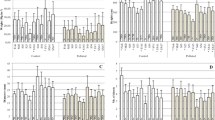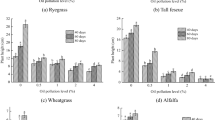Abstract
Over the past decades, the global production of petroleum coke, a by-product of the oil sand industry, has increased with the growing importance of oil sands as a source of fossil fuels. A greenhouse study using Triticum aestivum and Deschampsia caespitosa was conducted to assess the growth and physiological effects of coke on plants. The plants were grown in cokes with or without a cap of peat–mineral mix and were compared to plants grown in a peat–mineral mix (control). Our results indicate that the selected plants can survive in coke; however, stress symptoms such as reductions in transpiration (45–91%) and stomatal conductance rates (44–92%) in T. aestivum, biomass in T. aestivum (5–83%) and D. caespitosa (43–90%), photosynthetic pigments in T. aestivum (32–68%) and D. caespitosa (33–44%) and proline concentrations in D. caespitosa (77–97%) were observed. Furthermore, potentially phytotoxic concentrations of nickel (47–69 μg g−1 in D. caespitosa) and vanadium (9.3–18.3 μg g−1 in T. aestivum and 4–27.8 μg g−1 in D. caespitosa) were found in some tissues while molybdenum accumulated in D. caespitosa shoots at concentrations reported, in other studies, to cause molybdenosis in ruminants. These results suggest that the plants growing in coke could experience multiple stresses including water stress, nutrient deficiencies and/or Ni and V toxicity. Capping coke with peat–mineral mix limited the stress symptoms and could improve revegetation success of coke impoundment sites. This study provides baseline data for future long-term field studies essential for developing coke management guidelines.




Similar content being viewed by others
References
Adriano, D. C. (1986). Trace elements in the terrestrial environment. New York: Springer.
Ain-Lhout, F., Zunzunegui, M., Diaz Barradas, M. C., Tirado, R., Clavijo, A., & Garcia Novo, F. (2001). Comparison of proline accumulation in two Mediterranean shrubs subjected to natural and experimental water deficit. Plant and Soil, 230(2), 175–183.
Aller, A. J., Berna, J. L., del Nozal, M. J., & Deban, L. (1990). Effects of selected trace elements on plant growth. Journal of the Science of Food and Agriculture, 51(4), 447–479.
Brennan, R. F., & Adcock, K. G. (2004). Incidence of boron toxicity in spring barley in southwestern Australia. J Plant Nutr, 27(3), 411–425.
Clarkson, D. T., Eugénio, D., & Sara, A. (1999). Uptake and assimilation of sulphate by sulphur deficient Zea mays cells: the role of O-acetyl-l-serine in the interaction between nitrogen and sulphur assimilatory pathways. Plant Physiology and Biochemistry, 37(4), 283–290.
Chatterjee, C., Sinha, P., & Dube, B. K. (2005). Biochemical changes, yield, and quality of Gram under boron stress. Communications in Soil Science and Plant Analysis, 36(13–14), 1736–1771.
Chung, K. H., Janke, L. C. G., Dureau, R., & Furimsky, E. (1996). Leachability of cokes from Syncrude stockpiles. Environmental Science and Engineering Magazine, 3, 50–53.
Creelman, R. A., Mason, H. S., Bensen, R. J., Boyer, J. S., & Mullet, J. E. (1990). Water deficit and abscisic acid cause differential inhibition of shoot versus root growth in soybean seedlings. Plant Physiology, 92(1), 205–214.
Davies, B. H. (1976). Carotenoids. In T. W. Goodwin (Ed.), Chemistry and biochemistry of plant pigments (pp. 38–165). New York: Academic.
Elmore, C. D., & McMichael, B. L. (1981). Proline accumulation by water and nitrogen stressed cotton. Crop Science, 21(2), 244–248.
Ernst, W. H. O. (1996). Bioavailability of heavy metals and decontamination of soils by plants. Applied Geochemistry, 11, 163–167.
Fargašová, A. (1998). Root growth inhibition, photosynthetic pigments production, and metal accumulation in Sinapis alba as the parameters for trace metals effect determination. Bulletin of Environmental Contamination and Toxicology, 61(6), 762–769.
Ferguson, W. S., Lewis, A. H., & Watson, S. J. (1943). The teart pastures of Somerset: I. The cause and cure of teartness. Journal of Agricultural Science, 33(1), 44–51.
Flexas, J., & Medrano, H. (2002). Drought-inhibition of photosynthesis in C3 plants: stomatal and non-stomatal limitations revisited. Annals of Botany, 89(2), 183–189.
Forcella, F., Benech Arnold, R. L., Sanchez, R., & Ghersa, C. M. (2000). Modeling seedling emergence. Field Crop Research, 67(2), 123–139.
Frank, R., Stonefield, K. I., Suda, P., & Potter, J. W. (1982). Impact of nickel contamination on the production of vegetables on an organic soil, Ontario, Canada, 1980–1981. The Science of the Total Environment, 26(1), 41–65.
George, R. L. (1998). Mining for oil. Scientific American, 278, 84–85.
Glass, A. D. M. (2002). Nutrient absorption by plant roots: Regulation of uptake to match plant demand. In Y. Waisel, A. Eshel, & U. Kafkafi (Eds.), Plant roots, the hidden half (2nd ed., pp. 571–586). New York: Marcel Dekker.
Guller, L., & Krucká, M. (1993). Ultrastructure of grape-vine (Vitis vinifera) chloroplasts under Mg- and Fe-deficiencies. Photosynthetica, 29(3), 417–425.
Hendershot, W. H., Lalande, H., & Duquette, M. (1993). Soil reaction and exchangeable acidity. In M. R. Carter (Ed.), Soil sampling and methods of analysis (pp. 141–145). Boca Raton: Lewis.
Jacobs, D. L., & Otte, M. L. (2003). Conflicting processes in the wetland plant rhizosphere: metal retention or mobilization? Water, Air, and Soil Pollution, 3, 91–104.
Jones, J. B. (1998). Plant nutrition manual. New York: CRC.
Jones, K. C., Lepp, N. W., & Obard, J. P. (1990). Other metals and metalloids. In B. J. Alloway (Ed.), Heavy metals in soils (pp. 208–321). New York: Wiley.
Kaplan, D. I., Adriano, D., Carlson, C. L. C., & Sajwan, K. S. (1990). Vanadium: Toxicity and accumulation by beans. Water, Air, and Soil Pollution, 49, 81–91.
Kuja, A.L., Hutchinson, T.C. (1979). The use of native species in mine tailings revegetation. In Proceedings: Canadian Land Reclamation Association, fourth annual meeting, Regina, Sask., The Canadian Land Reclamation Association meeting, Regina, Canada, pp. 207–221.
Kukier, U., & Chaney, R. L. (2001). Amelioration of nickel phytotoxicity in muck and mineral soils. Journal of Environmental Quality, 30(6), 1949–1960.
Lawlor, D. W. (1979). Effects of water and heat stress on carbon metabolism of plants with C3 and C4 photosynthesis. In H. Mussell & R. E. Staples (Eds.), Stress physiology of crop plants (pp. 303–326). New York: Wiley.
Laza, R. C., Bergman, B., & Vergara, B. S. (1993). Cultivar differences in growth and chloroplast ultrastructure in rice as affected by nitrogen. Journal of Experimental Botany, 44(11), 1643–1648.
Liu, K., & Luan, S. (1998). Voltage-dependent K+ channels as targets of osmosensing in guard cells. The Plant Cell, 10(11), 1957–1970.
MacKinney, G. (1941). Absorption of light by chlorophyll solutions. The Journal of Biological Chemistry, 144(2), 315–323.
Maliszewska-Kordybach, B., & Smreczak, B. (2003). Habitat function of agricultural soils as affected by heavy metals and polycyclic aromatic hydrocarbons contamination. Environment International, 28(8), 719–728.
McGrath, S. P., & Smith, S. (1990). Chromium and Nickel. In B. J. Alloway (Ed.), Heavy metals in soils (pp. 125–150). New York: Wiley.
Nable, R. O., Bañuelos, G. S., & Paull, J. G. (1997). Boron toxicity. Plant and Soil, 193(1–2), 181–198.
Nelson, D. L., & Cox, M. M. (2000). Lehninger principles of biochemistry (3rd ed.). New York: Worth.
Neunhäuserer, C., Berreck, M., & Insam, H. (2001). Remediation of soils contaminated with molybdenum using soil amendments and phytoremediation. Water, Air, and Soil Pollution, 128(1–2), 85–96.
Raven, P. H., Evert, R. F., & Eichhorn, S. E. (1999). Biology of plants (6th ed.). New York: Worth.
Renault, S., MacKinnon, M., & Qualizza, C. (2003). Barley, a potential species for initial reclamation of saline composite tailings of oil sands. Journal of Environmental Quality, 32(6), 2245–2253.
Richards, J. E. (1993). Chemical characterization of plant tissue. In M. R. Carter (Ed.), Soil sampling and methods of analysis (pp. 115–139). Boca Raton: Lewis.
Rodenkirchen, H., & Roberts, B. A. (1993). Soils and plant nutrition on a serpentinized ridge in South Germany. II. Foliage macro-nutrient and heavy metal concentrations. Zeitschrift für Pflanzenernährung und Bodenkunde, 156(5), 411–413.
Sheppard, S. C., & Evenden, W. G. (1995). Systematic identification of analytical indicators to measure soil load on plants for safety assessment purposes. International Journal of Environmental Analytical Chemistry, 59(2–4), 239–252.
Singh, B. B. (1971). Effect of vanadium on the growth, yield and chemical composition of maize (Zea mays). Plant and Soil, 34(1), 209–213.
Sofo, A., Dichio, B., Xiloyannis, C., & Masia, A. (2004). Lipoxygenase activity and proline accumulation in leaves and roots of olive trees in response to drought stress. Physiologia Plantarum, 121(1), 58–65.
Squires, A.J. (2005). Ecotoxicological assessment of using coke in aquatic reclamation strategies at the Alberta oil sands. MSc thesis, University of Saskatchewan, Saskatoon.
Taylor, C. B. (1996). Proline and water deficit: Ups, downs, ins, and outs. The Plant Cell, 8(8), 1221–1224.
Uhart, S. A., & Andrade, F. H. (1995). Nitrogen deficiency in maize: II. Carbon–nitrogen interaction effects on kernel number and grain yield. Crop Science, 35(5), 1384–1389.
United Nations. (2006). Petroleum coke. Available via UNdata Energy Statistics Database. http://data.un.org/Data.aspx?d=EDATA&f=cmID:OG;trID:0924. Accessed 13 Jan 2009.
USEPA. (2006). Data quality assessment: Statistical methods for practitioners. Washington, DC: USEPA.
Woolhouse, H. W., et al. (1983). Toxicity and tolerance in the responses of plants to metals. In Lange (Ed.), Encyclopedia of plant physiology. Vol12. Physiological plant ecology III (pp. 245–300). Berlin: Springer.
Yang, X., Baligar, V. C., Martens, D. C., & Clark, R. B. (1996). Plant tolerance to nickel toxicity: I. Influx, transport, and accumulation of nickel in four species. Journal of Plant Nutrition, 19(1), 73–85.
Zhang, H., Zhao, F., Sun, B., Davison, W., & Mcgrath, S. P. (2001). A new method to measure effective soil solution concentration predicts copper availability to plants. Environmental Science & Technology, 35, 2602–2607.
Acknowledgements
The authors would like to thank Karen Kivinen, Carl Szczerski, Scott Green and Greg Morden for their technical assistance. We also would like to thank Wayne Tedder from Suncor Energy Inc. for providing petroleum coke and valuable input. Thanks to Dr. M. Sumner and the anonymous reviewers for providing critical reviews of the manuscript. Funding for this project was provided by Syncrude Canada Ltd., Suncor Energy Inc., Canadian Natural Resources Ltd. and the Natural Sciences and Engineering Research Council of Canada.
Author information
Authors and Affiliations
Corresponding author
Rights and permissions
About this article
Cite this article
Nakata, C., Qualizza, C., MacKinnon, M. et al. Growth and Physiological Responses of Triticum aestivum and Deschampsia caespitosa Exposed to Petroleum Coke. Water Air Soil Pollut 216, 59–72 (2011). https://doi.org/10.1007/s11270-010-0514-x
Received:
Accepted:
Published:
Issue Date:
DOI: https://doi.org/10.1007/s11270-010-0514-x




